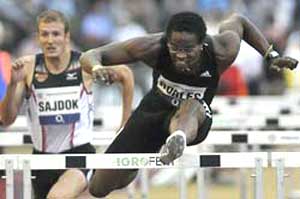
I’ll keep this article short, because if you’re talking about what makes Dayron Robles great, it should be pretty clear already. After breaking the world record in the men’s 110 meter hurdles with a 12.87, many people believe that Robles will take the record down even further before the end of the summer of 2008, and even below 12.80 before his career is over. He is only 21, you know.
What makes his 12.87 significant is that it makes him the new standard bearer in the event. Things were already shifting in his direction at the end of the 2007 season, when he pretty much dominated the European circuit in August and September. Then his blazing performances this past indoor season, when he flirted with the 60m hurdle world record, gave a good indication that he was going to do something special outdoors. No less an authority than the venerable Allen Johnson has stated that Robles is the favorite heading into Beijing, and AJ said that months ago, long before Robles dropped the 12.87. Even before that – when Robles ran 12.92 last summer – one of my athletes was insisting that Robles had already surpassed Liu Xiang. Well, let’s see what happens in Beijing before we crown him king.
But anyway, what makes Robles great? There are three things that stand out to me:
1) His lead leg is the truth. There is no other male hurdler to whom you can compare Robles’ lead leg. His lead leg is more like a woman’s in that it comes down on the hurdle. Which means not only that Robles is tall, but that he utilizes his height. Because his lead leg comes down on the hurdle (like a female hurdler), there is no horizontal element in his hurdle clearance. He doesn’t really have to “snap down” his lead leg because it’s already on the way down as it passes the crossbar. All he needs to do is pull the foot under his hips as he lands, just as any sprinter would do. Also, by angling the lead leg on that diagonal, downward slope, he enables himself to land closer to the hurdle, and thus gives himself more room to run between the hurdles, which explains why he doesn’t get crowded like a lot of other tall hurdlers do.
2) He has fixed his trail leg issues. His trail leg used to kick back before it came forward, adding an extra motion in its flight. The back-kick is gone.
3) As I mentioned in an article a day or two before the 12.87, Robles takes seven steps to the first hurdle. So, even without a great reaction time, he’s going to win the battle to the first hurdle simply because he can open up his stride more than the other guys. At this point, I might go so far as to say that anyone trying to beat Robles in the future may have to learn how to seven-step too. Things certainly seem to be headed in that direction.
I think there can be no doubt that Robles also has a great coach in Santiago Antunez, who also coached 2000 Olympic champion Anier Garcia. If Robles were just a phenomenal talent, he’d still be running in the 13.1-13.2 range. But every year he looks noticeably better than the year before, and he keeps dropping time. That’s coaching.
A couple of my athletes, who, like me, are always looking to find flaws in technique, have pointed out that Robles’ arms could be more efficient. But I have to say that I disagree. His elbows open up, which creates the illusion that his arms are too high. But no, his arms are fine. The key with the arms is that they have to move in an up-and-down motion, not a side-to-side motion. And Robles’ arms move in an up-and-down motion.
It’ll be interesting to see what Robles does in the rest of 2008, and if the likes of Liu Xiang, David Oliver, and others can challenge him for supremacy in the 110s.
© 2008 Steve McGill
Click here for youtube footage of Robles’ 12.87.
